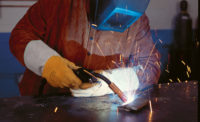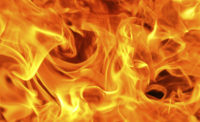Don't fuel the fire

U.S. fire departments respond to an estimated average of 10,500 structural fires in industry and manufacturing properties per year, according to the National Fire Protection Association (NFPA). These fires result in an average of 12 civilian deaths, 300 civilian injuries and $509 million in direct property damage, per year. The NFPA reports that in as many as 10 percent of those fires, the first item to ignite was a flammable or combustible liquid or gas, filter or piping.
Flammable and combustible liquids are used by virtually every industry in the world - medical, food processing, automotive, shipping, chemical, manufacturing, construction, sanitation, environmental and many more. Such liquids require special fire safety measures throughout their manufacture, processing, transportation, use and storage. As indicated by the NFPA’s statistics, improper handling of flammable liquids can pose serious safety risks and cause costly property damage. Undoubtedly, many of the fires reported by the NFPA could have been prevented or reduced in scope had flammable or combustible items been properly stored in approved flammable storage containers.
To encourage proper use and storage of flammable liquids, many industries and product manufacturers have independently developed their own guidelines for specific materials. However, OSHA maintains official regulation over flammable liquid storage in the U.S. In addition to OSHA, the NFPA is an excellent resource, providing recommended guidelines for flammable and combustible liquid storage.
Understanding classification
Both OSHA and NFPA classify burnable liquids into two categories: combustible and flammable. The flashpoint and boiling point determine the class of a liquid. (The “flashpoint” of a liquid is the minimum temperature at which a liquid gives off vapor within a test vessel in sufficient concentration to form an ignitable mixture with air near the surface of the liquid.)
Combustible liquids are defined as any liquid having a flashpoint at or above 100° F (37.8° C). Combustible liquids are then divided into two sub-categories. Class II liquids are combustibles with flashpoints at or above 100° F (37.8° C) and below 140° F (60° C), while Class III liquids are those with flashpoints at or above 140° F (60° C). Common examples of combustible liquids include paint thinner, home heating oils, motor oils, cooking oils, lubricating oils and diesel fuel.
Flammable liquids, also known as Class I liquids, are liquids that have a flashpoint below 100° F (37.8° C). Class I liquids are further divided into three subcategories. Class IA liquids have flashpoints below 73° F (22.8° C) and having a boiling point below 100° F (37.8° C). Class IB liquids have flashpoints below 73° F (22.8° C) and having a boiling point at or above 100° F (37.8° C). Class IC liquids have flashpoints at or above 73° F (22.8° C) and below 100° (37.8° C). Common examples of flammable liquids include styrene, acetone, benzene, toluene, hydrazine, some paints and solvent-based cements, motor and aviation gasolines, lacquers and lacquer thinner and some light crude oils. Class I liquids may be used only where there are no open flames or other sources of ignition within the possible path of vapor travel.
Storage options
Flammable and combustible liquids should always be kept in covered containers when not in use. Storage options for flammable and combustible liquids vary depending on the type of liquid being stored and the environment the liquid will be stored in.
One of the most common storage containers for flammable liquids are safety cans, which OSHA defines as approved containers of not more than five gallons capacity, and includes a spring-closing lid and spout cover. Safety cans are designed to carefully relieve internal pressure when subjected to fire exposure. Under OSHA regulations, up to two gallons of a Class IA flammable liquid can be stored in a safety can, while up to five gallons of a Class III combustible liquid is permissible. It is recommended that you purchase safety cans that are Factory Mutual (FM) or Underwriter Laboratory (UL) approved. Safety product suppliers offer a variety of safety can options for Class I and II liquids. For example, some new models feature a trigger mechanism that releases the liquid with precise timing, controlling the liquid flow.
Another approved storage option is flammable storage cabinets, which are available in a variety of styles and sizes to accommodate various flammable liquids and a range of quantities. OSHA limits the total amount of flammable liquid that can be stored in a flammable storage cabinet to 60 gallons of Class I or II liquids, and 120 gallons of Class III liquids.
Although multiple storage cabinets may be necessary for certain job sites, OSHA requires that a limit of three cabinets be located in a single fire area. The NFPA clarifies further for industrial settings that do not have walls or barriers within a facility (4.3.2 Exception 1). “In an industrial occupancy, additional cabinets may be located in the same fire area if the additional cabinets, or the group of not more than three (3) cabinets, is separated from the other cabinets or group of cabinets by at least 100 feet (30 m).”
When deciding to purchase flammable storage cabinets, be certain that the manufacturer follows OSHA safety guidelines in both the design and construction of its cabinets. OSHA regulations specify that flammable storage cabinets reach no more than 325° F (160° C) when subjected to a 10-minute fire test, and cabinets must be clearly labeled, “Flammable – Keep Fire Away.” Although exhaust ventilation systems are not required for storage cabinets, most have plugged fittings that can be used for such purposes.
Flammable storage rooms are an alternative storage option for large quantities of flammable liquids. The NFPA categorizes storage rooms into four groups. “Inside rooms” have no exterior walls, and “cut-off rooms” have either one or two exterior walls. “Attached buildings” share only one wall with another structure, while “liquid warehouses” are either separate buildings entirely or are separated by four-hour construction from adjoining areas.
Storage rooms are constructed to meet specific fire-resistant ratings, which are determined based on the liquids that will be stored inside the room. OSHA regulations require that approved self-closing fire doors be used, and the room must be liquid-tight where the walls join. In addition, a gravity or mechanical exhaust ventilation system must be in place in storage room and should provide for a “complete change of air within the room at least six times per hour,” according to OSHA regulations. OSHA also outlines regulations for the electrical wiring in storage rooms and in some cases requires automatic sprinkler systems to be installed.
Grounding and bonding
When flammable and combustible liquids are transferred from one container to another, a buildup of static electricity is generated. This static electricity can produce a spark that may result in a fire or explosion. How the liquid conducts electricity, the flashpoint, the ability of the liquid to generate static electricity and the surrounding environment (for example, the humidity) all play integral parts in the potential for fires and explosions. For these reasons, bonding and grounding is essential to safely storing flammable liquids. Bonding eliminates the electrical potential between two containers, while grounding eliminates the difference in potential static charge between the conductive object and the ground. Bonding and grounding is effective only if you are bonding and grounding to metal or special conductive plastic containers that eliminate the potential of sparking and static generation.
Looking for a reprint of this article?
From high-res PDFs to custom plaques, order your copy today!






